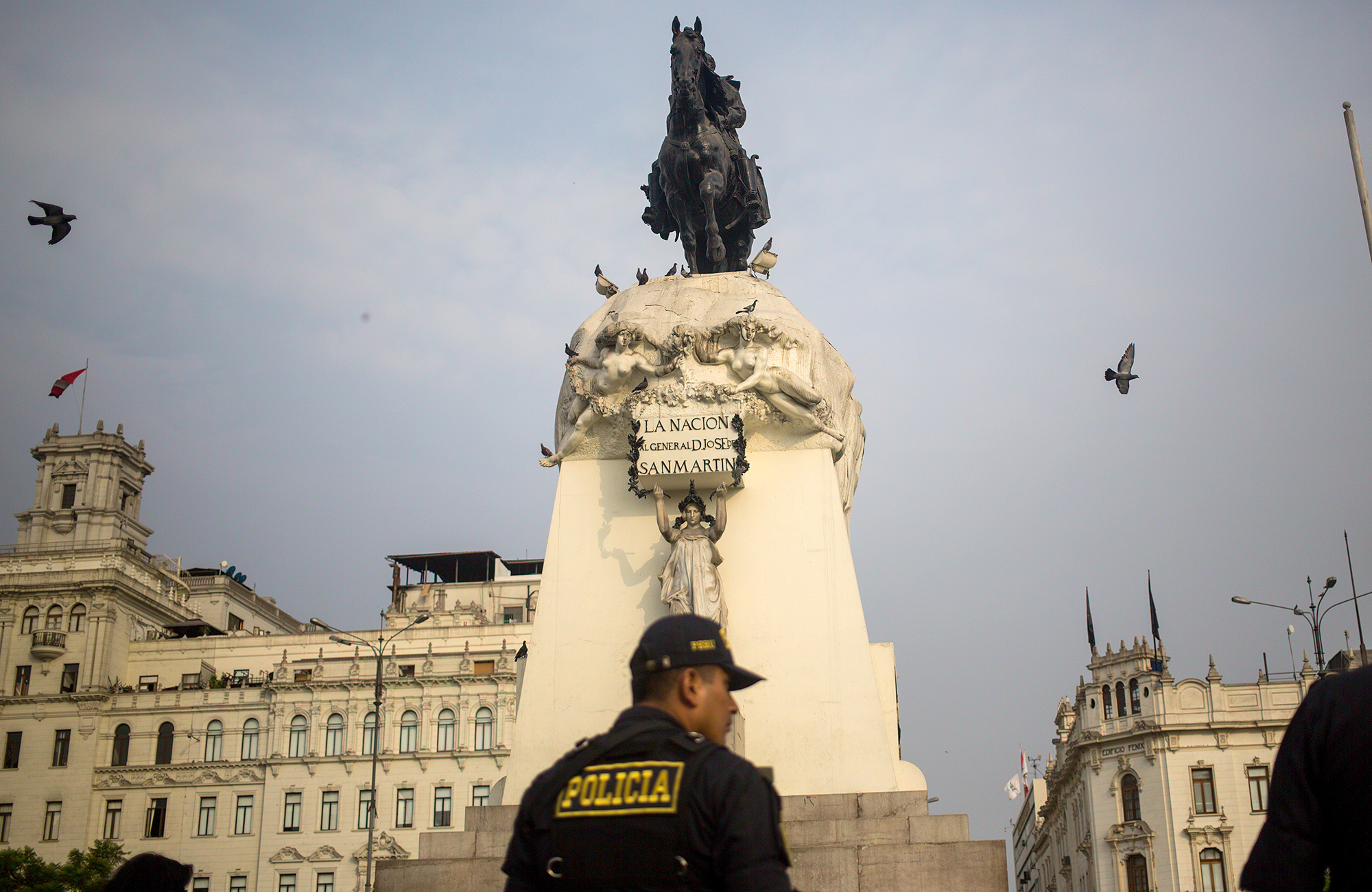
A police officer stands in Plaza San Martín in Lima, Peru. Authorities say crimes reported in the news media involve a tiny number of Venezuelans among the 700,000 who have come to Peru. (Photo by Nicole Neri/Cronkite Borderlands Project)
Venezuelans in Peru worry that media’s focus on crime spurs lies, hatred
By Mia Armstrong/ Cronkite Borderlands Project |
LIMA, Peru — “Will anything be done against the Venezuelan criminals who enter Peru?” reads the Twitter post. “I have read hundreds of news stories where they are involved in big robberies and MURDERS. Where are the rights of the Peruvian? Will they continue to protect these criminals? WILL YOU DO SOMETHING?”
“Venezuelan threatens a delivery man with a knife,” claims a Facebook video, and another on YouTube claims “VENEZUELA EXPORTS CRIMINALS AND SICKNESS.”
Facebook, Youtube, Twitter, Instagram and even some traditional news sites are crowded with posts like these. They have different messages, styles and intensities but are unified by an underlying assertion: Venezuelan migrants are a threat to Peruvians.
“The exact question would be, is Venezuelan crime statistically significant? No,” said Jerjes Loayza, a sociologist and lawyer in Lima. “But socioculturally, does it have a statistical impact? Yes, a tremendous one.
“Every crime committed by a Venezuelan tarnishes the reputation of hundreds of others in this city.”
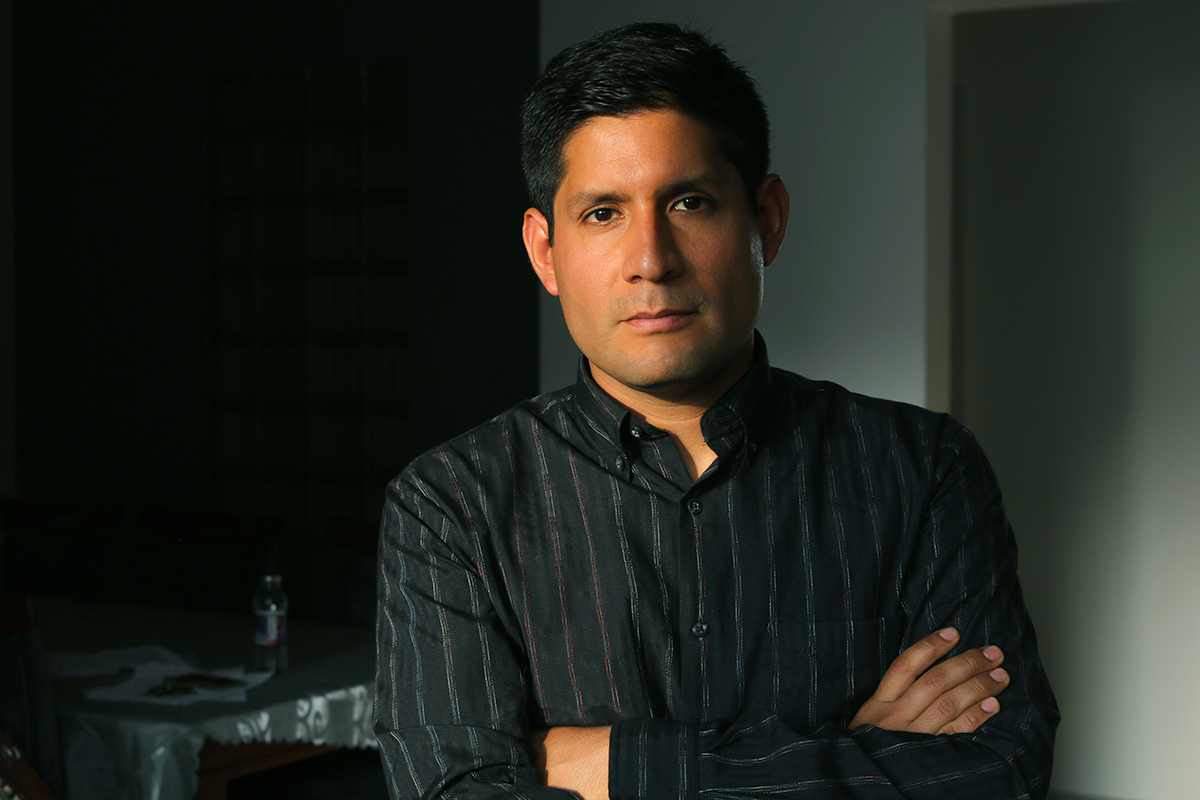
Jerjes Loayza, a Peruvian sociologist and lawyer, says the news media should be less sensational in coverage of Venezuelan migration and its effects on Peru. (Photo by Mia Armstrong/Cronkite Borderlands Project)
It’s a narrative that has accompanied mass migrations throughout time and across geography. And over the past 2½ years, Peru has found itself largely on the receiving end of the largest mass migration in the history of the Western Hemisphere: the exodus from Venezuela.
Thus far, more than 700,000 Venezuelan migrants who have fled their oil-rich, cash-strapped country because of hyperinflation, crime, corruption and shortages of food and medicine have been welcomed in Peru with relatively open arms.
For example, the government initially offered migrants the opportunity to normalize their legal status through a program called the Permiso Temporal de Permanencia, a renewable one-year temporary residency permit that allows migrants to legally work, study and open a bank account.
But even though Peru has a stable, growing economy, it still grapples with a poverty rate of 21 percent and enormous underemployment. The government has stopped offering temporary legal residency to migrants entering the country after Oct. 31, 2018, although Lima is considering establishing a new “humanitarian visa.”

Lima, the capital of Peru, is home to 9.32 million people, close to a third of the country's total population. (Photo by Mia Armstrong/Cronkite Borderlands Project)
Peru so far has walked a difficult tightrope on immigration. Brazil, Panama and Ecuador have had high-profile incidents of xenophobia against Venezuelan migrants, but Peru has not.
However, there are growing signs that Peruvian attitudes toward Venezuelan migrants are changing.
According to a survey released in February by the Institute of Public Opinion at the Pontifical Catholic University of Peru, 55.6 percent of Peruvians agreed or strongly agreed that “many Venezuelans engaged in criminal activities in Peru.”
Forty-five percent of respondents indicated they believed “the majority of Venezuelans are untrustworthy or dishonest people,” and 37.5 percent of respondents indicated they were afraid of the Venezuelans arriving in Peru.
Fear of crime in Peru was widespread long before the recent migration, but that fear now has a new target.
In 2018, 81.1 percent of Lima residents identified lack of public safety as a principal problem in their city, according to an annual survey conducted by Lima Como Vamos a nonprofit group that measures quality of life in the capital and one of its suburbs, Callao. That was up from 75.4 percent in 2017. According to the survey, 57.5 percent said they felt unsafe in Lima.
Lima Como Vamos has not directly studied the impact of Venezuelan migration on crime perception. But Ana Claudia Oshige, a project coordinator for the organization, said residents have told her they feel threatened by the newcomers when she has spoken in neighborhoods with large numbers of migrants.
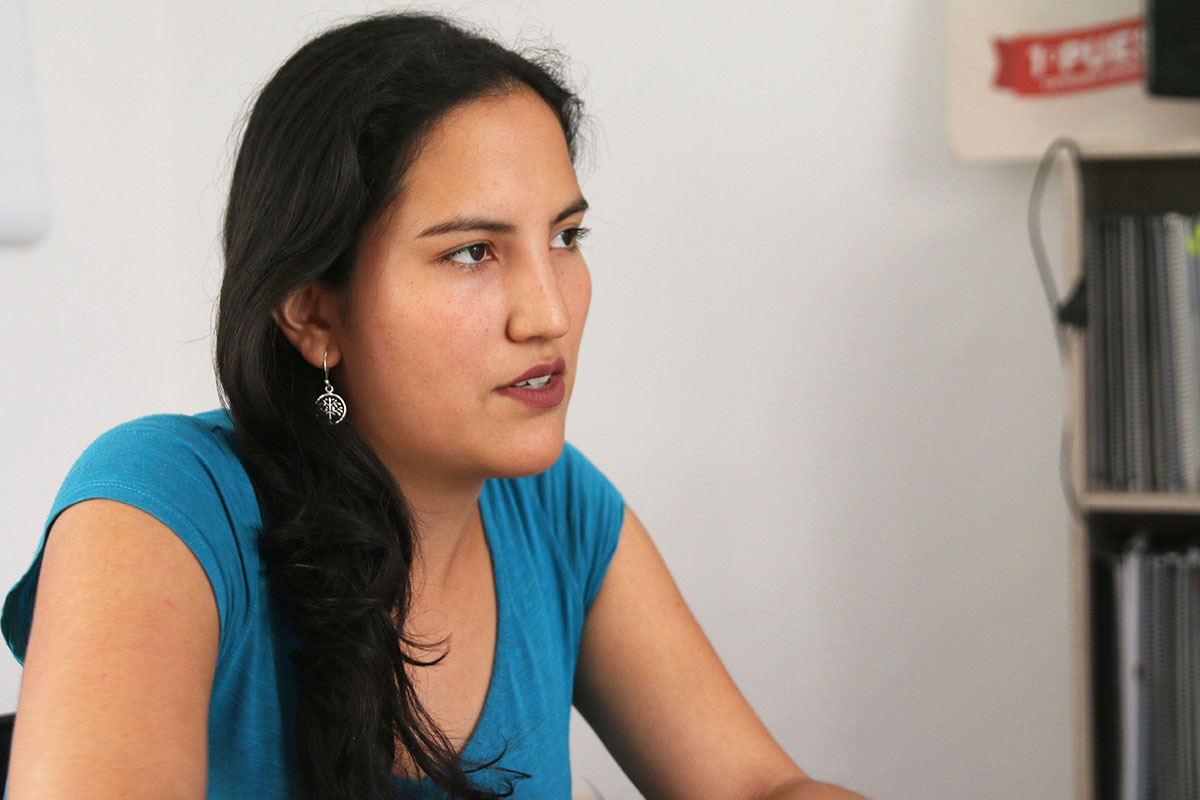
Ana Claudia Oshige, a project coordinator for Lima Como Vamos, says the focus on crime contributes to a heightened perception of insecurity among Lima residents. (Photo by Miranda Cyr/Cronkite Borderlands Project)
“Lima is a city of immigrants,” she said, “and in spite of that, I think we forget it when other people come.”
It’s a familiar sentiment for Anamer Salazar Chirinos, who felt welcome when she came to Peru in 2017, toward the beginning of the Venezuelan exodus. Since then, she said generalizations in traditional news and social media about Venezuelans and crime have contributed to views that Venezuelans are not “people who can do good.”
Now, she fears an uncertain future for Venezuelans in Peru.
“I won’t deny that there are Venezuelans who are behaving very badly,” said Salazar, who recently moved from Lima to Cusco in part to escape the growing xenophobia she felt. “But we’re all paying for sinners. We’re all at a standstill because of those sinners.”
Col. Ángel Francisco Merino Céspedes, director of international affairs for the National Police of Peru and the director of Interpol in Lima, said he didn’t have the data to definitively say whether Venezuelan migrants had had any significant impact on Peru’s overall crime rate. He emphasized that crimes reported in the news media involve a tiny number of Venezuelans among the hundreds of thousands who have come to Peru.
“In this phenomenon of migration … professionals have come, technicians have come, people have come with a great desire to work, to overcome,” he said. “But individuals with criminal tendencies have also come, people who have been committing crimes in Venezuela. And we can’t lose sight of the fact that Caracas (Venezuela’s capital) is currently the most violent city in the world, right? So people have come who are part of this group with criminal difficulties.”
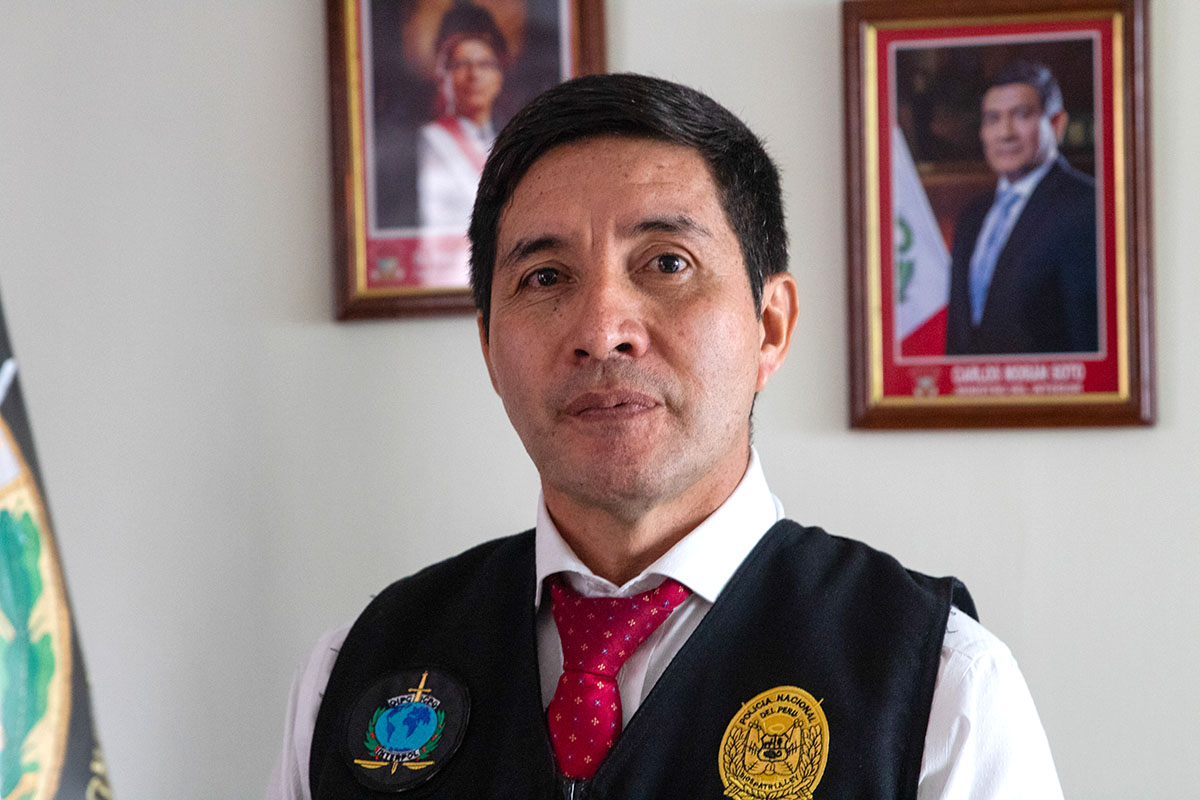
Col. Ángel Francisco Merino Cespedes, director of international affairs for the National Police, says hate crimes against migrants have been reported in Peru. (Photo by Kailey Broussard/Cronkite Borderlands Project)
Despite media focus on crimes committed by Venezuelans, Merino Céspedes said the National Police had not recorded any hate crimes against migrants.
“Unlike what we’ve seen in Brazil, unlike what we’ve seen to an isolated extent in Ecuador, in Peru there haven’t been … demonstrations of discrimination … against Venezuelan citizens,” he said. “It’s true that suddenly in some spaces there’s been pushback because (Venezuelans) came and occupied space as street vendors. But there haven’t been any attacks.
“For that matter, I think the Peruvian has received the Venezuelan citizen very well.”
Still, the risk for misinformation and negative generalization is high, especially with the speed and reach of the internet and social media.
Daniel Funke, who researches and reports on misinformation for the Poynter Institute’s International Fact-Checking Network, said false stories related to status and safety tend to be quickly accepted and rapidly dispersed. The consequences can quickly leap from cyberspace to real life.
Already, false information about perceived outsiders on WhatsApp is thought to have contributed to lynchings in Mexico and India (in these cases, the victims were subjects of false rumors that they were child abductors). False information also played a role in elections in Brazil and the United States. And Facebook (which owns Instagram and WhatsApp), YouTube, Twitter and other social media giants are struggling to prevent the weaponization of their platforms. Meanwhile, independent fact checkers are attempting to refute false information already in circulation.
“Most false stories or hoaxes that are good have some source of truth in them that makes them just believable enough that someone will share it, but their conclusiones will be wrong,” Funke said.
In this case, stories that link migration and crime have both those elements: They do have a kernel of truth – some Venezuelans have committed crimes in Peru – and they capitalize on existing fears about safety.
From July to December 2018, 26.1 percent of Peruvians 15 or older were the victim of some criminal act, according to the National Institute of Statistics and Informatics. And although the crime rate is high in Peru, the perception of insecurity is even higher. The same study found that 86.6 percent of Peruvians 15 or older living in an urban area believe that in the next 12 months, they could be the victim of a criminal act. That’s a 1.1 percentage point increase from the same period in 2017.
Nicolas Parent, a researcher at the Universidad del Pacífico in Lima who has studied risk perception related to migrant communities in Turkey and now in Peru, said new and social media are principally responsible for “sustaining the divide between” real and perceived risk, especially as it relates to migration.
“When we talk about those perceptions of risk and we talk about xenophobia, crime is realistically the … primary instrument where that actually takes place,” Parent said.
Because crime is an emotional topic that appeals to the “reptilian part of our brains,” he said, it only takes a few allegations of misdeeds to fuel xenophobia.
There have been more than a few such stories in Peru.
In August, the government detained five members of El Tren de Aragua, a Venezuelan “mega-gang,” generating a flurry of news reports and widespread worry, as the English publication InSight Crime put it, that “criminals in the troubled Andean nation are migrating and sometimes carrying their criminal habits with them.”
At the time, the director of the National Police’s criminal investigations division, Juan Carlos Sotil, said at least 15 members of the gang had entered Peru in previous weeks to “commit a series of crimes, principally against financial entities” and to “install a headquarters of their criminal organization,” according to Peruvian news outlets.
Earlier last summer, the country was shocked by an armed assault on a jewelry store in Jockey Plaza, a popular Lima shopping mall. The heist was committed by a group of 12, of whom 11 reportedly were Venezuelan.
In such cities as Trujillo, Arequipa and Cusco, there also have been news stories of Venezuelans robbing homes and businesses.
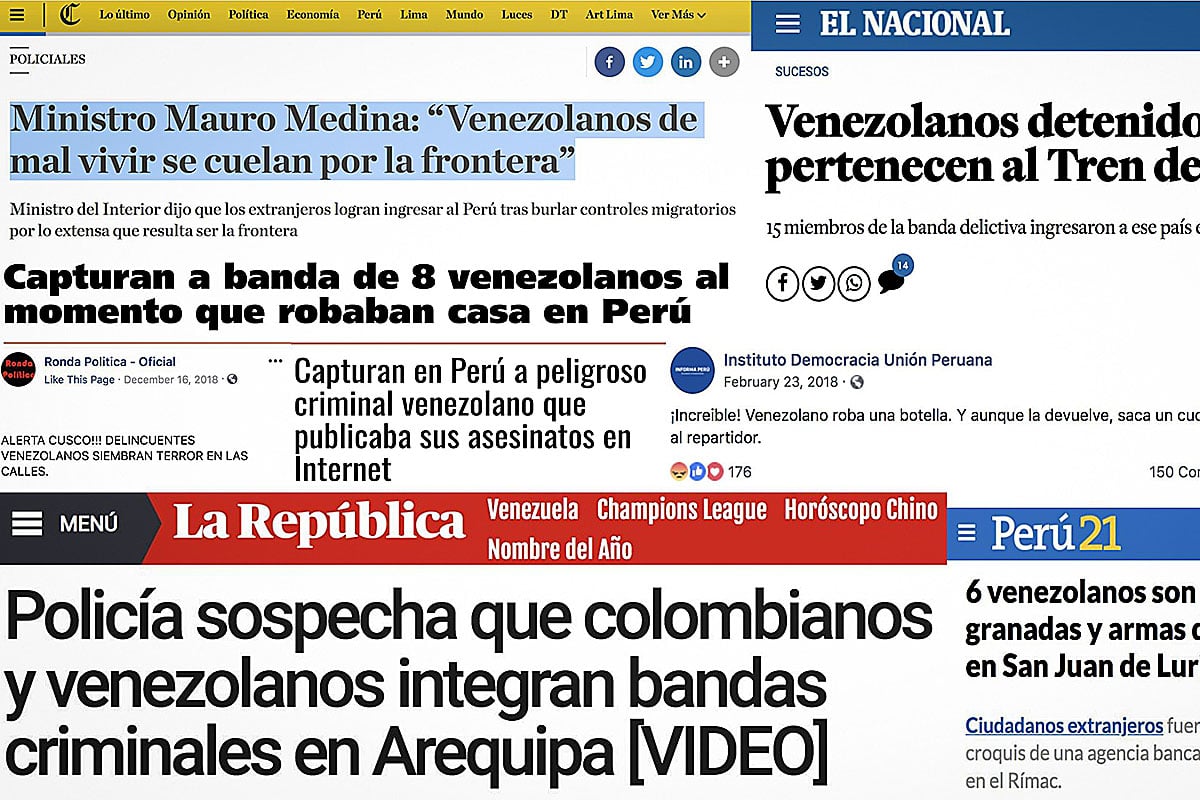
A photo illustration of headlines and social media posts discussing Venezuelans allegedly involved in crime. (Collage by Mia Armstrong/Cronkite Borderlands Project)
The journalists behind these stories face a challenge: Crime news draws internet clicks, sells papers and boosts advertising rates but can also incite repercussions.
Mario Paulo Spray Velasco, a politics and crime reporter for América TV, said crime stories are plentiful because that’s what interests the audience. But covering crime in Peru isn’t easy. On a normal day, Spray might look through 20 often-gruesome police reports. Few victims and witnesses come forward, and fewer are interested in talking to reporters.
Witnesses who do talk often describe suspects as “Venezuelan,” Spray said. His and other reputable news organizations usually avoid including suspects’ nationality in their reports, Spray said, aware that unconfirmed or unnecessary details of that sort could augment xenophobia.
But Spray said there are plenty of more sensationalist news outlets that act with far less caution.
Diego Salazar, a Peruvian journalist behind the blog No hemos entendido nada (Spanish for We’ve Understood Nothing), has seen this more sensationalist coverage extend to mainstream media in Peru. In a blog post from early 2018, he highlighted such headlines as “Venezuelans recorded trying to assault a passer-by in Tumbes” in La República. and “Facebook: Venezuelan and Peruvian involved in intense fight in bus” in El Comercio, both respected mainstream outlets.
This sort of framing, he wrote, sustains the perception of a “conflict between Venezuelans (them) and Peruvians (us).”
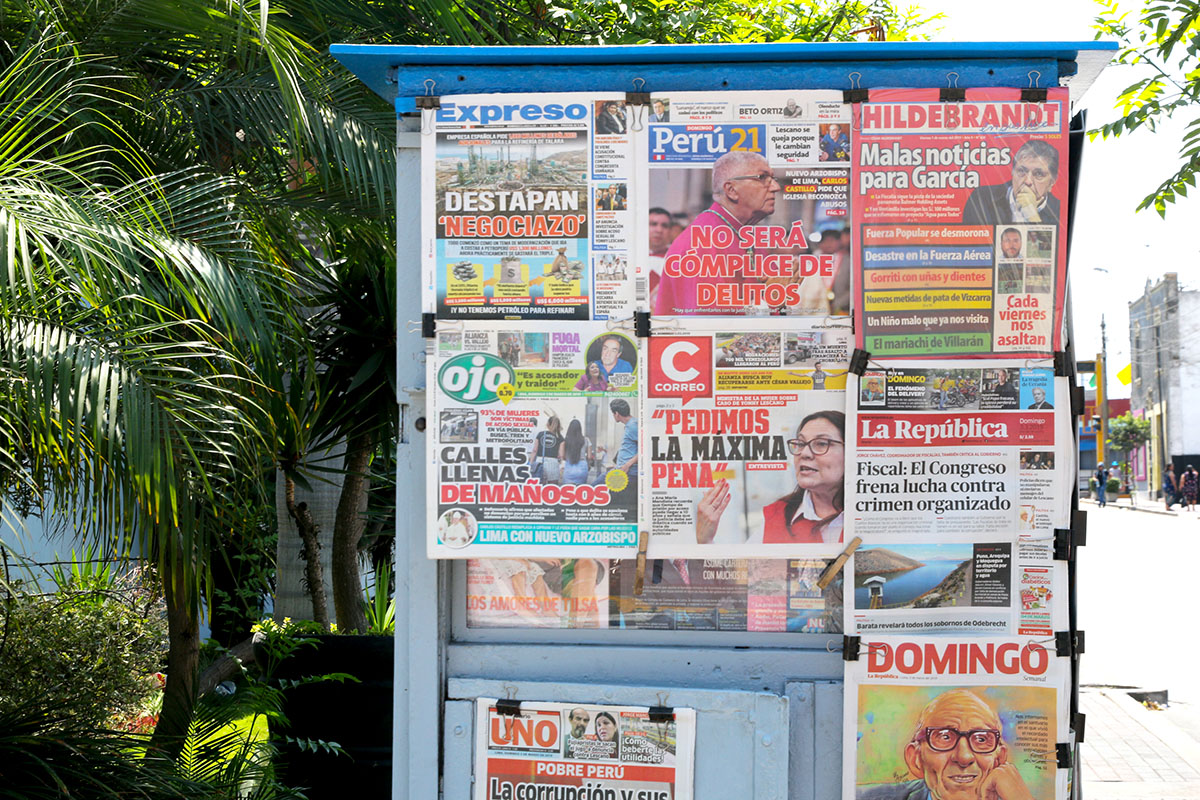
A newspaper stand in Lima, Peru, with front pages full of stories about crime, in early March. (Photo by Mia Armstrong/Cronkite Borderlands Project)
For Anamer Salazar, the 2017 Venezuelan immigrant, this sense of conflict is very much alive, even after moving to Cusco, where she and her boyfriend run a small digital marketing business from their apartment. She recalled a conversation with a woman in Cusco who told her she was afraid to let her children ride the bus late “because there were too many Venezuelans in the street.”
“The truth is, I felt really bad … but like I said, there are good days and bad days,” Salazar said.
Domingo Díaz also has seen good and bad days since he came to Peru from Venezuela in 2014. Recently, though, his days have been pretty good. He spends most of his time running his business, a multimedia content creation agency, out of his apartment in Miraflores, considered the nicest district in Lima. His office is framed by wooden shelves stacked with cameras and video equipment. These are the lenses through which he has seen the world, particularly Lima.
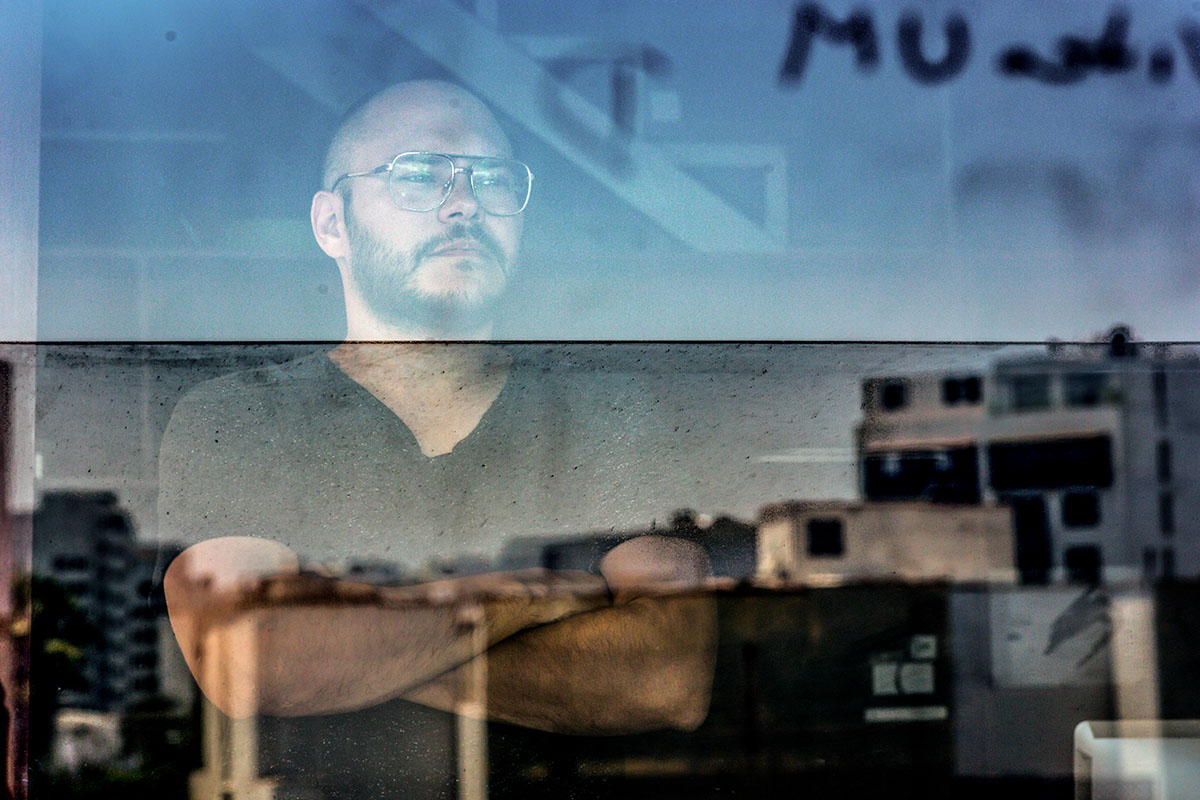
Domingo Diaz is a political asylee, a status he partly earned by spending three days incarcerated for supporting student protests in Venezuela. He has lived in Peru since 2014. (Photo by Nicole Neri/Cronkite Borderlands Project)
Most of what he has seen is the open arms of Peruvians who’ve wanted to help him. His message to them is one of gratitude, his words are propelled by positivity, and his lips seem to nearly always curl warmly in a smile.
Díaz is a political asylee, a status he partly earned by spending three days incarcerated for supporting student protests in Venezuela. The country’s effectively defunct legal system often encouraged political persecution and violence, he said.
According to the Venezuelan Observatory of Violence’s annual report for 2018, the country’s murder rate was 81.4 per 100,000 residents – the highest in Latin America.
Díaz hopes that someday soon that number will go down, and Venezuelans will be able to return home.
“We Venezuelans have a problem. We leave our country but we left our hearts over there,” Díaz said. “Peru has been very good to me … when you leave a country the way Venezuelans have left the country, you get empty. You get a void … it can’t be filled, even with money, even with anything.”
At times, the homesickness many Venezuelans feel has been compounded by negative perceptions that have played out more loudly and publicly, including in Lima’s most recent mayoral race.
Ricardo Belmont Cassinelli, a well-known television personality who served as mayor of Lima in the early 1990s, made headlines last August for arguing that “disorderly migration” threatens jobs and public order.
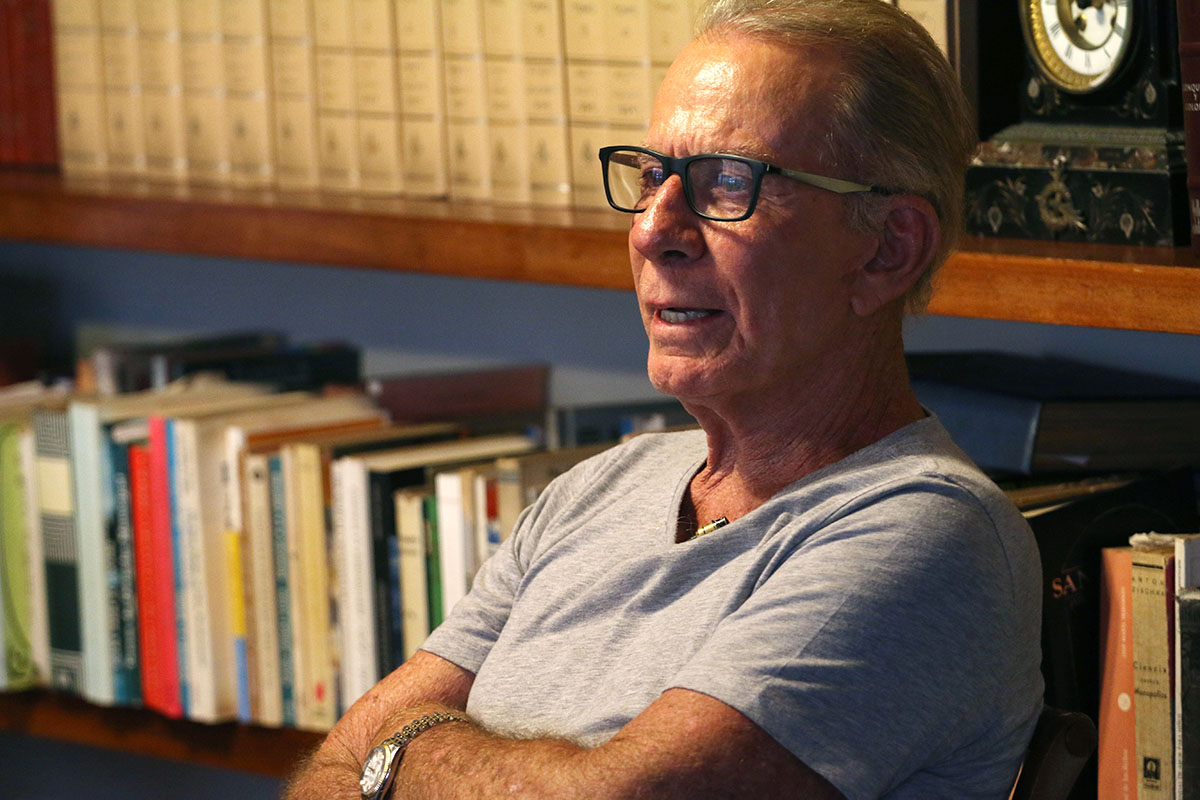
Former Lima mayor Ricardo Belmont Cassinelli raised the issue of migrants causing crime and disease in last year's mayoral race. He placed fifth. (Photo by Miranda Cyr/Cronkite Borderlands Project)
Belmont lost the race, in what Oscar Pérez, a former Venezuelan politician who now lives in Lima, said was a rejection of his messages about migration.
“Instead of offering Lima residents alternatives so that the city could continue to grow in a harmonious way, he (Belmont) focused his campaign on attacking Venezuelans,” Pérez said. “And we saw how he ended up in fifth place, which means that people did not buy those messages, did not buy those messages loaded with xenophobia, loaded with discrimination, loaded with hate.”
Now, Belmont spends most of his time focused on building his personal media entities, primarily through Facebook and Youtube.
His videos are often filmed in his apartment, which occupies the top floors of a building perched on a cliff overlooking the Pacific Ocean. From his office, you can see almost all of Lima, where he has spent most of his life.
He said he focuses his videos on opening a conversation about the type of country Peru wants to be, which to his mind is a country that “respects the constitution,” “is free, independent, sovereign,” and “understands that the state has to exist.”
Belmont said emphatically that he isn’t against migration, but he is against disorderly migration.
“We’re not going to close the door on any of our Latin American brothers,” he said. “But it has to be ordered, organized migration, just like they do in all countries around the world.”
Belmont worries that when people enter the country “indiscriminately,” it’s hard to know whether they have a criminal record and why they came to Peru. But in Peru, a criminal background check, carried out by the International Criminal Police Organization, known as Interpol, is one of the many steps migrants must complete to be eligible for a temporary residency permit and other benefits.
Belmont rejects the label xenophobe.
“I have no problem with anyone who comes to my country, as long as it’s under order,” he said.
Belmont has his own criticism for Pérez, founder of the Venezuelan Union in Peru, which Belmont considers a political organization. The union denies that classification, instead emphasizing its work as a social aid organization.
That work has made Pérez and the union well-known to most anyone with connections to the Venezuelan migration in Lima: U.S. diplomats, Peruvian politicians, academic researchers and, of course, the migrants.
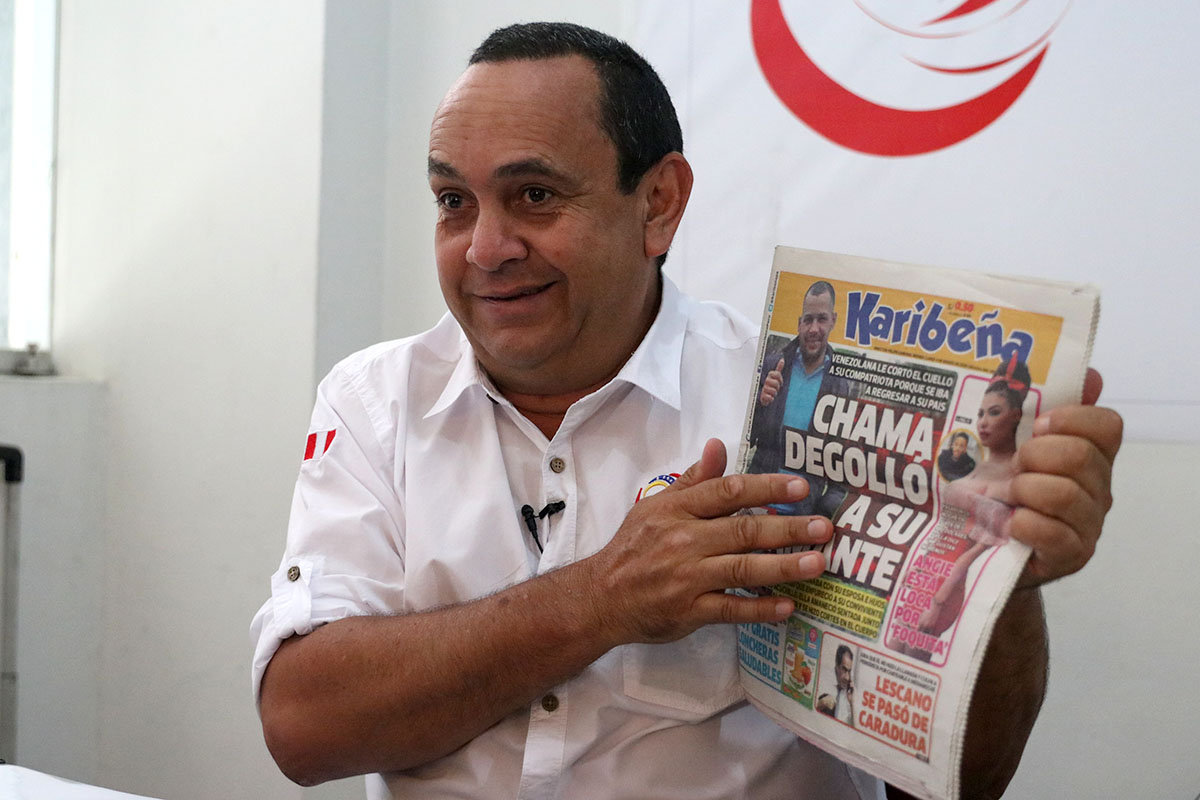
Oscar Pérez, president of the Unión Venezolana en Perú, holds up a Peruvian newspaper dated March 5 that discusses Venezuelans. (Photo by Paulina Verbera/Cronkite Borderlands Project)
When Pérez arrived in Peru 10 years ago, he was one of the few Venezuelans in the country. As that began to change, he realized that his fellow Venezuelans had skills, education and dreams but few opportunities to use or attain them. With the hopes of bridging that gap, he founded the union in 2015.
One of the group’s key goals, executive director Martha Fernandez said, is to “be part of the solution,” to ensure that “migration is positive” for Peru. One of the ways it does so is by pushing for the revalidation of medical and law degrees by Peru so that Venezuelan professionals can fill gaps in services, especially in rural parts of the country.
Although online media has spread bad messages and false information about Venezuelans, the Venezuelan Union in Peru and similar groups are employing it to connect Venezuelans with resources and spread positive messages.
The hashtag #losbuenossomosmás, or “There are more of us who are good,” has collected many of these positive messages in an attempt to counter negative narratives about Venezuelans.
Loayza, the sociologist and lawyer, is encouraged that the large number of Venezuelan migrants in Peru now is seen as normal.
Loayza, who teaches at the Pontifical Catholic University of Peru and the Main National University of San Marcos, said he doesn’t think Peruvian society has truly accepted Venezuelans, but he thinks the situation has arrived at a “phase of tolerance.”
In February, Pérez used the hashtag #losbuenossomosmás for a post about José Antonio Perdomo, a Venezuelan who ran a portable barber stand in the streets of Lima. Pérez called Perdomo an example of “honesty and creativity” for which Venezuelans should feel proud.
Perdomo has made his way through three countries cutting hair: Ecuador, Colombia and Peru. His journey hasn’t been easy.
He arrived in Lima on Dec. 1, 2018, and that night, he was robbed while in a taxi. For the next six weeks, he slept in a park near the center of the city.
On a warm afternoon in March, he stood in the same park, focused on giving a shave to Paolo Rojas, an Argentinian who’s a regular customer. Perdomo, who calls his business “Barbero Express,” unpacked a portable generator, chair, razors and an electric trimmer, sanitation materials and a mirror from the cart he pushes around Lima.
Perdomo’s goal is to work, he said, and to work honestly. He has had some bad experiences with “people who get confused, who generalize,” but he also has encountered Peruvians who welcome Venezuelans with open arms.
Since March, Perdomo has moved back to Quito, Ecuador, where he continues to cut hair. It was difficult to work in Lima, he said, and he didn’t feel right there. Now, he’s desperately seeking somewhere he belongs, and someone – a government, an individual, anyone – who can help him get there.
He doesn’t know exactly what the place he’s searching for will look like, or where it will be. He doesn’t know quite how to describe it.
He’ll know it when he gets there.
Cronkite Borderlands Project is a multimedia reporting program in which students cover human rights, immigration and border issues in the U.S. and abroad in both English and Spanish.










Leave a Comment
[fbcomments]